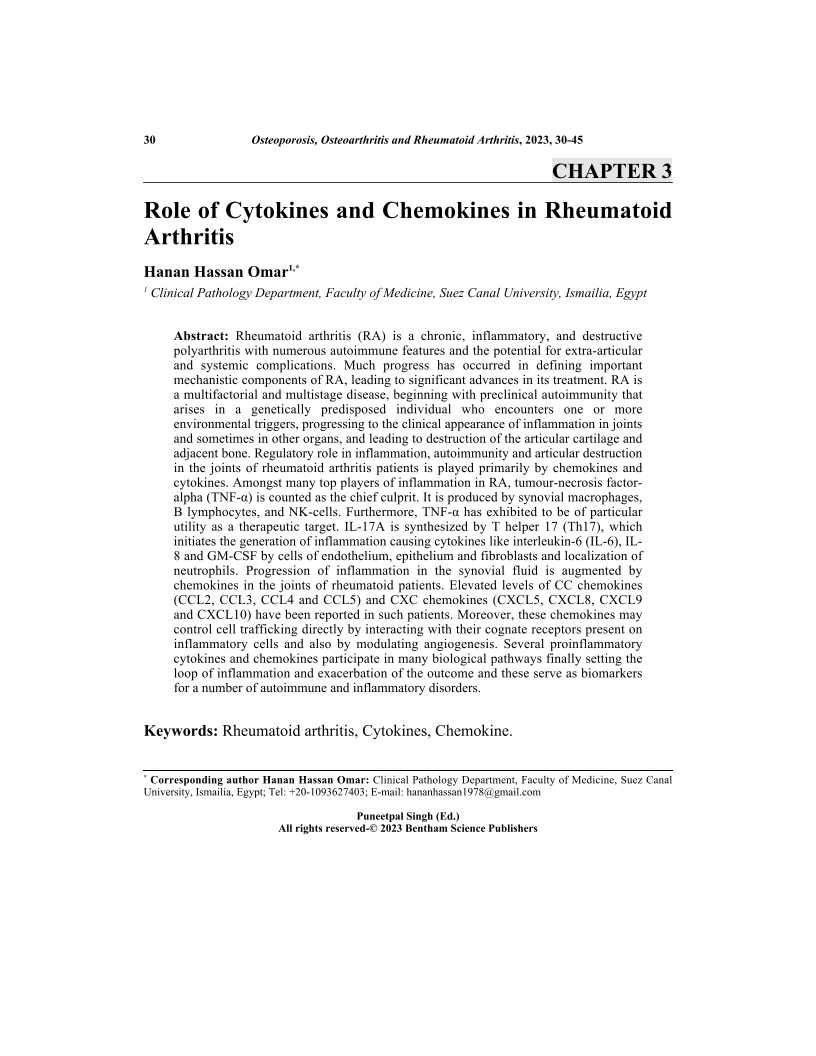Role of Cytokines and Chemokines in Rheumatoid Arthritis

- By Hanan Hassan Omar1
-
View Affiliations Hide Affiliations1 Clinical Pathology Department, Faculty of Medicine, Suez Canal University, Ismailia, Egypt
- Source: Osteoporosis, Osteoarthritis and Rheumatoid Arthritis: An Agonizing Skeletal Triad , pp 30-45
- Publication Date: November 2023
- Language: English
Role of Cytokines and Chemokines in Rheumatoid Arthritis, Page 1 of 1
< Previous page | Next page > /docserver/preview/fulltext/9789815196085/chap3-1.gif
Rheumatoid arthritis (RA) is a chronic, inflammatory, and destructive polyarthritis with numerous autoimmune features and the potential for extra-articular and systemic complications. Much progress has occurred in defining important mechanistic components of RA, leading to significant advances in its treatment. RA is a multifactorial and multistage disease, beginning with preclinical autoimmunity that arises in a genetically predisposed individual who encounters one or more environmental triggers, progressing to the clinical appearance of inflammation in joints and sometimes in other organs, and leading to destruction of the articular cartilage and adjacent bone. Regulatory role in inflammation, autoimmunity and articular destruction in the joints of rheumatoid arthritis patients is played primarily by chemokines and cytokines. Amongst many top players of inflammation in RA, tumour-necrosis factor-alpha (TNF-α) is counted as the chief culprit. It is produced by synovial macrophages, B lymphocytes, and NK-cells. Furthermore, TNF-α has exhibited to be of particular utility as a therapeutic target. IL-17A is synthesized by T helper 17 (Th17), which initiates the generation of inflammation causing cytokines like interleukin-6 (IL-6), IL-8 and GM-CSF by cells of endothelium, epithelium and fibroblasts and localization of neutrophils. Progression of inflammation in the synovial fluid is augmented by chemokines in the joints of rheumatoid patients. Elevated levels of CC chemokines (CCL2, CCL3, CCL4 and CCL5) and CXC chemokines (CXCL5, CXCL8, CXCL9 and CXCL10) have been reported in such patients. Moreover, these chemokines may control cell trafficking directly by interacting with their cognate receptors present on inflammatory cells and also by modulating angiogenesis. Several proinflammatory cytokines and chemokines participate in many biological pathways finally setting the loop of inflammation and exacerbation of the outcome and these serve as biomarkers for a number of autoimmune and inflammatory disorders. nbsp;
-
From This Site
/content/books/9789815196085.chap3dcterms_subject,pub_keyword-contentType:Journal -contentType:Figure -contentType:Table -contentType:SupplementaryData105

